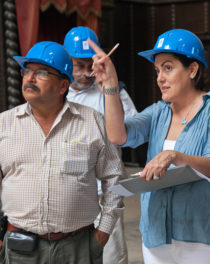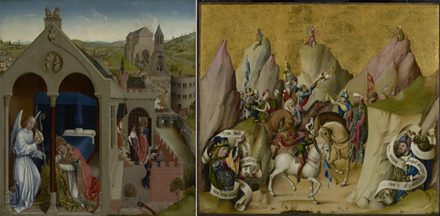When you’re in a field that studies the past, it’s easy to forget just how much can happen in a mere ten years. But the end of the decade gives us a chance to reflect on the things that have made an impact on our own work and on our broader communities.
This decade at Getty, we’ve seen new tools lead to new discoveries under the surface of a Rembrandt painting, watched as Instagram changed the museum experience, and embarked on projects that bring people together across the globe—to name just three.
We asked a handful of Getty staffers from various areas of expertise to share their thoughts on what stood out for them as the key development of the past decade. Themes of collaboration, innovation, and open access quickly emerged.
While this is not an exhaustive list, it’s certainly something to toast to!
1. Museums Embrace the Open Web
At the beginning of the decade, Getty’s Online Scholarly Catalogue Initiative was just getting underway. Museums were making modest explorations into digital publishing with ebooks and apps, using tools like Apple’s iBooksAuthor and Adobe Digital Publishing Suite. Google was digitizing books by the tens of thousands. And with the exception of the scrappy and creative “Books in Browsers” conference, conversations about digital publishing and the future were happening in the context of big trade-focused events like Book Expo America and O’Reilly Media’s important Tools of Change conference. Digital publishing was about business and tech. Today, for us, it’s about open—open-source software, open licensing, and the open web.
Digital publishing hit the mainstream with the release of Amazon’s Kindle (more business and tech!). That was 2007, so the field is just entering its teenage years. And like good teenagers we’re rebelling, we’re writing manifestos (or at least think pieces and user studies) we’re locked in our rooms hacking away at our computers finding new ways of putting books out on the open web.
The most rebellious of all are perhaps the librarians. Yes, the librarians. Mission-driven, patron-focused, born into a world built on the free sharing of books and unencumbered by the weight of print-publishing traditions, the librarians are the vanguard of open publishing. Look no further that the Library Publishing Coalition and its annual meeting—where every other word is “open” and everything else is “digital”—and follow them into the future.
—Greg Albers, Digital Publications Manager, Getty Publications
2. Access to Digital Resources Grows Exponentially
The biggest thing I’ve seen in the last decade? Not easy to answer given how much technological change we’ve witnessed since 2000. Back then, the iPhone and iPad weren’t even available. Today, in 2019, over 238 tools are used in the digital humanities community, according to Weltliterature.net, A Black Market for the Digital Humanities.
As a scholar of networks in the art market, I am a frequent user of Gephi, software that is important for exploring and visualizing networks. And, while I’m incredibly grateful for the community that supports this tool as I could not do my network analysis without it, something else is even “bigger” for me—access.
Access to high-quality images from important collecting institutions. Access to archival sources. Access to public domain books. Access to data. This has been absolutely transformative for the discipline. And what is critically important to me as a scholar is that this content is authoritative and reliable—and, best of all, free!
For my network analysis work, I rely on the Getty Provenance Index; for bringing together high-quality images, technical analysis, and scholarly acumen, I like to point to Getty’s Online Scholarly Catalogue Initiative; and the Getty Research Portal, which contributes to HathiTrust (#7 on the Weltliterature list), is a treasure trove of materials from around the globe.
— Anne Helmreich, Associate Director, Digital Initiatives, Getty Research Institute

Scientific staff at the Getty Conservation Institute set up to carry out an X-ray fluorescence scan of Coronation of the Virgin, by Gentile de Fabriano, c. 1420, from the collection of the J. Paul Getty Museum
3. Imaging Technology Leads to New Discoveries
Advances in imaging over the last decade have changed the way researchers “see” objects, helping us better understand how objects were made and how they may have changed (or be changing) over time. This is essential to our understanding of an object’s past, and helps us predict its future.
Two particularly exciting developments are macro-X-ray fluorescence scanning and hyperspectral imaging. Together, these tools provide a nearly complete map of the different materials used across, and below, the surface of an object, enabling researchers not only to identify what materials are present but also to reconstruct the artistic process.
In 2015, these technologies helped us visualize the hidden figure under Rembrandt’s Old Man in Military Costume, and enabled scholars to identify a link between the size of the sheets of gold leaf on 15th-century Italian gold ground panel paintings and the location where the paintings were created.
As we move into the next decade, imaging technologies will continue to advance, and new tools will be introduced, enabling even more exciting discoveries to be made.
— Karen Trentelman, Senior Scientist, Getty Conservation Institute

Connecting Art Histories scholars at the Shah-i-Zinda Necropolis, Samarkand, Uzbekistan. Photo © Mirela Ljevakovic 2012
4. International Exchange Powers Cultural Understanding
The question of cultural heritage and its influence on national identity continues to be a powerful source of debate in the 21st century. The challenge is to create mutual understanding across borders—literal political borders as much as the perceived ones that divide us. Promoting transnational contact is important now more than ever.
I’m proud of the role Getty has played in fostering international exchange through the Foundation’s Connecting Art Histories initiative. Grants awarded over the past ten years have benefitted more than 1,000 scholars in the field of academic art history from 80 countries worldwide, bringing them together for seminars, workshops, and sustained side-by-side research experiences.
Outstanding senior scholars mentor younger participants from different countries, oftentimes engaging with concepts of transit and encounter, as well as the conflicts, resistance, and mistranslation that often occur when diverse cultures intersect. We’ve heard repeatedly that participants come away with new ideas and lines of inquiry to bring to their work, and greater openness to the relevance of histories and artistic traditions beyond their own.
— Miguel de Baca, Senior Program Officer, Getty Foundation
5. Archives Embrace More Expansive Perspectives
The archives profession is small, but we’ve thrown ourselves into a variety of activities over the last decade. Our community has endeavored to improve access to an increasingly broad range of historical records nationally and internationally.
You can see this through the development of Social Networks and Archival Context, which helps people discover information about the people, families, and organizations that are documented in historical resources. ArchiveGrid also became freely available in the last decade, allowing access to 5 million collections of records from institutions around the world.
As an integral part of this desire to provide access to information, archivists have engaged in robust efforts to reflect the broad expanse of peoples, cultures, perspectives, and orientations that have always existed, but have often been excluded from the historical and/or professional record.
Examples of these efforts range from free courses from Society of American Archivists to help archivists consciously engage with these concepts on a daily basis to aggregations of resources to help archivists create more responsible and accurate descriptions of collections .
— Nancy Enneking, Head of Institutional Archives, Getty Research Institute

Nailed it? With Orazio Gentileschi’s Danaë at the Getty Center. Photo: Sarah Waldorf
6. Visitors Drive Their Own Museum Experience with Social Media
Ten years ago, museums were just beginning to experiment with social media as a way to start conversations. #AskaCurator Day launched in 2010 on Twitter, giving people an avenue to ask questions they’d always wondered. Today, providing access to the experts, objects, and stories that make up museum life is integral to how museums use social media. (We do read your DMs, we promise.)
In the mid-2010s, the rise of photo-sharing sites, along with better camera phones, FOMO, and a change in museum photography policies helped drive the rise of the art selfie. Beyonce’s art selfie at the Louvre went viral, and soon museums were asking: are selfies at museums a good thing?
Museums today can still be traditional spaces to pause and reflect on art, but they’re also places to play and create. To pose and photograph yourself in a museum is a way to see yourself as an artwork. It’s the reason we see the caption “I’m the real artwork” on so many photos tagged here at the Getty Center. (We’ve also seen the rise of selfie museums like the Museum of Icecream and 29Rooms.)
The decade has brought reflection about the impact social media has on privacy, productivity, mental health, and the trustworthiness of our leaders, government, and media. And we’re asking, how might we use social media to add historical context to current events, to share stories that connect people to each other, and to encourage curiosity in the world?
— Sarah Waldorf, Social Media Lead, Getty Trust
7. Museums Grapple with Diversity, Equity, and Inclusion
The arts field has been waking up to the challenges of diversifying museum audiences and staff in the past decade. The Mellon Foundation’s Art Museum Staff Demographic Survey released in 2015 was a critical moment in highlighting the problem. It’s not a new one. In1993, we founded the Getty Marrow Undergraduate Internship program to provide paid internships in museums and visual arts organizations to over 100 college students each summer who come from underrepresented cultural backgrounds.
In the last ten years, an increasing number of institutions are engaging with this work in wide-ranging ways, from adopting formal DEIA policies to instituting implicit bias training. It is clear the work must continue if we are going to achieve more diverse, accessible, equitable, and inclusive cultural organizations.
— Katie Underwood, Assistant Director, Communications, Getty Foundation

Installation view of Talking to Action: Art, Pedagogy, and Activism in the Americas at Otis College of Art and Design, Ben Maltz Gallery, 2017.
8. Museums Collaborate Regionally
Los Angeles has clearly come into its own as a major center of the art world in the past decade. It’s gratifying to think that Getty’s Pacific Standard Time played a role in this. I can still recall the excitement when PST debuted in September 2011, with 68 exhibitions across Southern California all focused on the history of post-war art in Los Angeles.
There was a profound sense in the art community that L.A. was now culturally “on the map” in a new way. For me, there was probably nothing more gratifying than seeing all the artists gather for the opening at the Getty Center to celebrate their extraordinary contributions to the history of modern art.
Looking back, it’s also clear that PST introduced a new model of collaboration: museums working together to present thematically linked exhibitions at the same time and at an unprecedented scale. Getty has continued the model, first with PST: LA/LA in 2017 and now looking ahead to PST: Art x Science x LA, which will debut in 2024.
— Joan Weinstein, Director, Getty Foundation





Comments on this post are now closed.